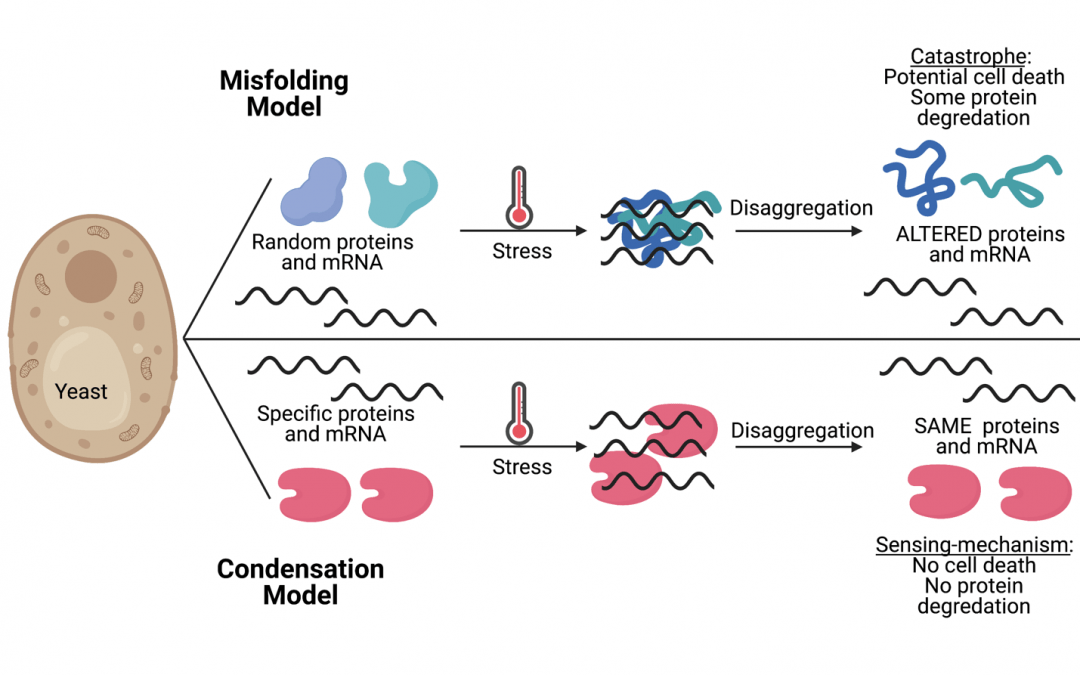How do our cells respond to heat?
From flying a drone on mars to developing mRNA vaccines, scientific understanding and modern medicine have made incredible progress. However, when it comes to biology, some of the most basic questions remain hotly debated.
For example, how do cells sense temperature?
This is the question University of Chicago researcher Sammy Keyport, member of Dr. D. Allan Drummond’s lab, asks every day. Keyport, a graduate student studying genetics, has always been interested in how organisms interact and respond to their environment.
As an undergraduate at Loyola University Chicago, she bridged her interest in ecology with her technical training in molecular biology to study how invasive plant species affect bacterial communities. It was through her work in genetically sequencing these bacteria that she became interested in, and decided to pursue, genetic research. Upon her arrival at UChicago, she became interested in the heat shock response– how a cell responds to the environmental stress of increased temperature– after taking one of Drummond’s classes.
“The question that motivated me to study the heat shock response was that fundamentally we don’t understand how cells sense temperature,” explained Keyport. “It’s very intriguing for me. It seems like a huge, unsolved problem.”
Challenging the status quo
The heat shock response involves the clustering of proteins and mRNA into “condensates,” in a process known as condensation. To recover from stress, these condensates must be pulled apart by proteins known as chaperones, the most famous of which is heat shock protein 70 (Hsp70).
Historically, it was believed that protein clusters were mostly composed of misfolded proteins and were nothing more than a harmful byproduct of stress. In contrast, the Drummond lab proposes that protein clustering is the key to the heat shock response, and an important adaptation for cells to survive stress.
“Our hypothesis is that this condensation process is a sensing mechanism [of stress]. I think this is a relatively novel idea, as condensation was only recently discovered in the past few decades,” explained Keyport.
More specifically, the Drummond lab predicts that these clusters of proteins act as “stress sensors,” which come together in condensates following stress.
While Keyport’s model predicts condensation to be reversible and non-toxic to the cell, it has previously been believed that condensates contain misfolded proteins, which would lead to a negative outcome for the cell. Furthermore, the condensation model has an added layer of specificity. The proteins that condense are the same specific “stress-sensitive” proteins every time, whereas classical misfolding would be random.
If proteins were randomly misfolded during the condensation process, they would be expected to have a certain level of degradation or loss of function. However, the Drummond lab has previously shown that this is not the case. The proteins that form the condensate are recoverable and functional following the heat shock response.
Modeling stress responses
To investigate her hypothesis, Keyport focuses most of her attention on yeast.
Yeast? As in, from bread?
Saccharomyces cerevisiae, also known as Brewer’s yeast or Budding yeast, is a common laboratory species. Yeast cells replicate quickly, have a similar structure to human cells, and are easy to manipulate genetically. In short, they represent a simplified system researchers can use to ask basic questions about what goes on in a cell.
In the Drummond lab, these basic questions center around the heat shock response, which is widely conserved across species. “From bacteria to a human, all cells must be able to survive environmental stress. They all must have responses to increased temperature or toxins,” clarified Keyport. “Interestingly, they all respond the exact same way, by forming protein clusters.”
Identifying stress sensors
What would it mean for a protein to be a stress sensor? Keyport expects it would likely be able to bind the chaperone Hsp70, since Hsp70 is linked with the activation of the heat shock response.
With this in mind, Keyport surveyed known proteins that form condensates during heat stress in yeast for a place to which Hsp70 could bind. She was able to identify a variety of candidate proteins. Interestingly, these proteins were all associated with the production of ribosomes, which are the proteins responsible for protein synthesis- i.e., the proteins that help make other proteins.
Ribosomes are particularly important during cellular growth and division, processes which are disrupted during stress responses. Keyport hypothesizes that the ribosome-forming proteins are held in condensates during heat shock, and the presence of these condensates not only triggers further stress responses but also halts cellular growth.
While Keyport’s research addresses a fundamental gap in scientific knowledge, it also has potential clinical relevance. Protein misfolding and accumulation is most famously associated with ALS and dementia, where disease severity and patient diagnosis is linked to protein clusters in neurons. In the case of disease, the neurons fail to break apart these clusters.
“If we can figure out the normal response to protein clusters, we can maybe figure out what is going wrong in the case of disease,” said Keyport. Understanding why these clusters form in the first place, and under what environmental conditions, may explain on what is different in disease and inform therapeutic strategies.
By Jen Allocco
Jen is a PhD candidate in the Alegre lab at the University of Chicago. A member of the Committee on Immunology, her research focuses on immune responses to transplanted organs.
This article was written in collaboration with the myCHOICE Writing for Communications and Marketing Careers workshop, hosted by Marina Damiano of the Damiano group.

